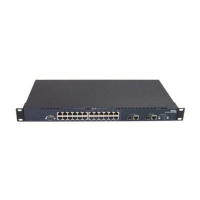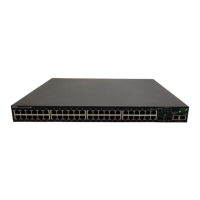794 BigIron RX Series Configuration Guide
53-1002253-01
Filtering
26
• If a device receives a route whose ORIGINATOR_ID attribute has the value of the device’s own
router ID, the device discards the route and does not advertise it. By discarding the route, the
device prevents a routing loop.
• The first time a route is reflected by a device configured as a route reflector, the route reflector
adds the CLUSTER_LIST attribute to the route. Other route reflectors who receive the route
from an IBGP neighbor add their cluster IDs to the front of the route’s CLUSTER_LIST. If the
route reflector does not have a cluster ID configured, the device adds its router ID to the front
of the CLUSTER_LIST.
• If the device configured as a route reflector receives a route whose CLUSTER_LIST contains the
route reflector’s own cluster ID, the route reflector discards the route and does not forward it.
Configuration procedures
All configuration for route reflection takes place on the route reflectors, not on the clients.
Enter the following commands to configure a device as route reflector 1 in Figure 26.4 on
page 26-42. To configure route reflector 2, enter the same commands on the device that will be
route reflector 2. The clients require no configuration for route reflection.
BigIron RX(config-bgp)# cluster-id 1
BigIron RX(config-bgp)# neighbor 10.0.1.0 route-reflector-client
BigIron RX(config-bgp)# neighbor 10.0.2.0 route-reflector-client
Syntax: [no] cluster-id <num> | <ip-addr>
The <num> | <ip-addr> parameter specifies the cluster ID and can be a number from 1 –
4294967295 or an IP address. The default is the router ID. You can configure one cluster ID on
the router. All route-reflector clients for the router are members of the cluster.
If the cluster contains more than one route reflector, you need to configure the same cluster ID on
all the route reflectors in the cluster. The cluster ID helps route reflectors avoid loops within the
cluster.
To add an IBGP neighbor to the cluster, enter the following command.
Syntax: neighbor <ip-addr> route-reflector-client
For more information about the neighbor command, refer to “Configuring BGP4 neighbors” on
page 771 and “Configuring a BGP4 peer group” on page 778.
Filtering
This section describes the following:
• “Filtering AS-paths” on page 795
• “Filtering communities” on page 798
• “Defining and applying IP prefix lists” on page 799
• “Defining neighbor distribute lists” on page 800
• “Defining route maps” on page 801

